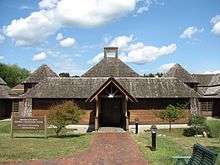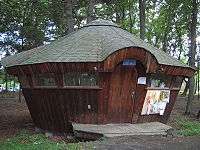Yiddish Book Center
 The Yiddish Book Center is located on the campus of Hampshire College. | |
 Location within Massachusetts | |
| Established | 1980 |
|---|---|
| Location |
1021 West Street Amherst, MA 01002 |
| Coordinates | 42°19′19″N 72°31′40″W / 42.322°N 72.527703°W |
| Website |
www |
The Yiddish Book Center (National Yiddish Book Center), located on the campus of Hampshire College in Amherst, Massachusetts, United States, is a cultural institution dedicated to the preservation of books in the Yiddish language, as well as the culture and history those books represent. It is one of ten western Massachusetts museums constituting the Museums10 consortium.
History
The Yiddish Book Center was founded in 1980 by Aaron Lansky, then a twenty-four-year-old graduate student of Yiddish literature and, as of 2016, the center's president. In the course of his studies, Lansky realized that untold numbers of irreplaceable Yiddish books were being discarded by American-born Jews unable to read the language of their Yiddish-speaking parents and grandparents. He organized a nationwide network of zamlers (volunteer book collectors) and launched a campaign to save the world’s remaining Yiddish books. Lansky recounts the origins of the center in his 2004 memoir, Outwitting History.[1]
At the time Lansky began his work, scholars estimated there were 70,000 Yiddish books still extant and recoverable. Since then, the Yiddish Book Center has recovered more than a million volumes, and it continues to receive thousands of new books each year from around the world.
In 1997, the Yiddish Book Center moved to its current site in Amherst, Massachusetts, a 49,000-square-foot complex that echoes the rooflines of an East European shtetl (Jewish town). The center is home to permanent and traveling exhibits, a Yiddish book repository, educational programs, and the annual Yidstock: The Festival of New Yiddish Music.
Collections
The center has drawn on its duplicate holdings to distribute books to students and scholars, and to establish or strengthen collections at more than 700 research libraries, schools, and museums around the world.
The Yiddish Book Center includes a number of different collections:
- In 1997, with a grant from the Righteous Persons Foundation, the Center launched its Steven Spielberg Digital Yiddish Library, which has digitized and cataloged more than 12,000 Yiddish titles and made them available for free download from the Internet Archive.[2] In 2012, the Yiddish Book Center formed a partnership with the National Library of Israel, which was launching its own project to digitize its entire Hebrew-alphabet collection, including thousands of Yiddish titles. The effort prompted The New York Times to declare Yiddish "proportionately the most accessible literature on the planet". As of the end of 2014, the titles in the Steven Spielberg Digital Yiddish Library have been downloaded 1.3 million times.
- The David and Sylvia Steiner Yizkor Books Collection comprises hundreds of yizkor books, memorial volumes commemorating Jewish communities in East Europe that were destroyed in the Holocaust. The books in the collection can be searched online.
- The Noah Cotsen Library of Yiddish Children's Literature includes about 800 titles, both original Yiddish works and Yiddish translations of classic stories written in other languages. The majority of the titles, which come from the YIVO Institute for Jewish Research as well as from the center's own collection, have been digitized and included in the Steven Spielberg Digital Yiddish Library.
- The Sami Rohr Library of Recorded Yiddish Books is a collection of roughly 150 titles, including novels, short stories, nonfiction works, memoirs, essays, and poetry. The recordings were made at the Jewish Public Library of Montreal (JPL) in the 1980s and '90s by native Yiddish-speaking volunteers.
- The Frances Brandt Online Yiddish Audio Library comprises recordings of lectures by, and interviews with, writers and poets who visited the JPL between 1953 and 2005. The Yiddish Book Center is now working with the JPL to digitize the recordings. Ultimately, approximately 1,100 recordings from the collection will be digitized and accessible.
Public programs and resources
The center offers public programs related to Yiddish and Jewish culture. Each year, the center hosts two visiting exhibits in its Brechner Gallery. It also has a number of permanent exhibits: the Lee & Alfred Hutt Discovery Gallery, an interactive exhibit on Jewish cultural identity; Unquiet Pages focused on Yiddish literature; A Living Connection: Photographs from the An-sky Expeditions, 1912-14 on the work of ethnographer S. An-sky; Sholem-Bayes: Reflections on the American Jewish Home; the Nancy B. Weinstein, Kindervinkl (children's corner); the Appelbaum-Driker Theater, with exhibits on Yiddish film and radio; and a reproduction Yiddish Print Shop with displays about the Yiddish press in the twentieth century.
Pakn Treger (Yiddish for "book peddler"), the magazine of the Yiddish Book Center, is an English-language magazine that covers subjects related to Yiddish culture and literature as well as news from the center. Its annual translation issue, a digital publication, features newly-translated works of Yiddish literature.
Educational programs
The center's educational programs include the Steiner Summer Yiddish Program for college students, the Great Jewish Books Summer Program for high school students, a Great Jewish Books Teacher Workshop, a fellowship program, a translation fellowship, and Tent: Encounters with Jewish Culture, as well as online and on-site classes for adult learners, including YiddishSchool. The center also offers a field trip program for middle and high school students.
In 2001, Ruthe B. Cowl (1912–2008) of Laredo, Texas, donated $1 million to create the Jack and Ruthe B. Cowl Center, which promotes "Yiddish literary, artistic, musical, and historical knowledge and accomplishment" at the center. Early in 2007, Cowl donated another $750,000 to create the Cowl Jewish Leadership Program for promising college students.
Translation initiative
In 2013, the center launched a translation effort that includes a translation fellowship program; a publishing venture; Taytsh.org, a website and interactive resource for working Yiddish-to-English translators;[3] and an annual digital Pakn Treger translation anthology.
Criticism
The organization's history has been controversial from the start. Lansky's claims that Yiddish was in a state of obsolescence provoked the ire of many people long-involved in Yiddish cultural activities.[4] His invocation of Yiddish nostalgia for the purposes of fundraising has also been the subject of debate, both among Yiddish cultural activists and by critics of "ethnic marketing".[5] Lansky rankled initial supporters again when the new center was built by a non-union contractor that had no collective bargaining agreement with its workers.[6] Despite claims that this was offensive given the role of Yiddish speakers in the founding of the American labor movement and trade unions, petitioners from the Jewish Labor Committee and the United Brotherhood of Carpenters and Joiners of America were ignored.[6]
The manner in which the center raises and spends its funds has also been the target of criticism. According to the organization's IRS Form 990, Lansky's 2008 salary was reported as more than $195,000. Since the bulk of the organization's funds are spent on the salaries of the top three employees and on fundraising, the independent charity evaluator Charity Navigator rated its efficiency a zero, or "exceptionally poor", and the overall organization as "poor" in 2008. As of 2011 Charity Navigator gives the National Yiddish Book Center an overall score of three stars out of four, based on a financial-performance score of two out of four stars and an "Accountability & Transparency" score of four out of four stars.[7]
References
- ↑ "Outwitting History - Algonquin Books - Books For A Well-Read Life". Algonquin Books - Books For A Well-Read Life. Retrieved 13 September 2015.
- ↑ "Yiddish Book Center's Spielberg Digital Yiddish Library". archive.org. Retrieved 13 September 2015.
- ↑ "Yiddish Book Center". Yiddishbookcenter.org. Retrieved August 21, 2016.
- ↑ Lansky, Aaron (2004). Outwitting History: The Amazing Adventures of a Man Who Rescued a Million Yiddish Books. Chapel Hill, N.C.: Algonquin Books of Chapel Hill. pp. 48–49. ISBN 1-56512-429-4.
- ↑ Halter, Marilyn (2000). Shopping for Identity: The Marketing of Ethnicity. New York, N.Y.: Random House. pp. 79–80. ISBN 978-0-8052-1093-4.
- 1 2 Jewish Labor Committee press release, May 12, 1995.
- ↑ "Charity Navigator Rating - National Yiddish Book Center". Charity Navigator. Retrieved 13 September 2015.
External links
- Official website
- Books digitized by Yiddish Book Center in the Internet Archive
- Yizkor Books | Memorial Volumes Commemorating Jewish Communities Destroyed in the Holocaust
- Pakn Treger, the magazine of the Yiddish Book Center,
Coordinates: 42°19′19.20″N 72°31′39.73″W / 42.3220000°N 72.5277028°W
